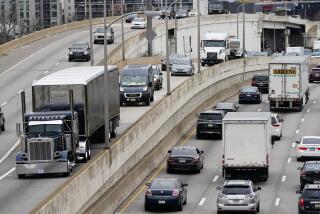Putting a Stop to Brake Failures
- Share via
The ultimate nightmare of almost every motorist is brake failure, leaving no way to quickly and safely stop a car.
But with all the modern safety features, a lot of motorists wonder whether brake failures ever occur. If you doubt it’s a real hazard, ask Vice President Dan Quayle and his wife, Marilyn.
The brakes on the Quayles’ Chevrolet Suburban failed while they were heading for the Winter Olympics in the French Alps earlier this month, a White House spokesman said. The driver was forced to use the emergency brake to stop on a narrow, snowy road.
“I just assumed we were going to probably have to turn at a 45-degree angle or a 180-degree angle and hit the side of the mountain,” Quayle was quoted as saying. “But the driver was able to apply the emergency brake and stop it.”
The Quayles were unhurt in their little adventure, but it prompts an interesting question: How many people die or get hurt as a result of brake failures each year? Nobody knows.
Each year, 44,000 Americans die on the highway and many more are seriously injured.
Of the fatalities, 30,000 are occupants of passenger cars. Beyond that, nobody has a good idea of what caused those deaths, said Brian O’Neill, president of the Insurance Institute for Highway Safety.
The National Highway Traffic Safety Administration, the government agency in charge of auto safety, does not tabulate causes of fatal accidents. Local police seldom probe the causes of crashes unless a lawsuit is filed. All too often, the blame is put on the motorist.
“It is an oversimplification to say the vast majority of accidents are driver error,” O’Neill said. “If a tractor-trailer jackknifes and kills someone, the police report says the truck was going too fast for the conditions. So it is put down as driver error. But it may well have been that the truck had badly adjusted brakes.”
Bad brakes do kill.
Runzheimer International, a consultant to operators of large commercial fleets, reported recently that Indiana police officer Thomas Kleis died in an accident last year in which the anti-lock braking system on his Chevy Caprice police cruiser was suspected of failure.
And the Center for Auto Safety, a consumer organization in Washington, D.C., recently released a study that found the government is investigating possible defects in braking systems on Big Three cars, including one complaint involving General Motors cars linked to 48 reported accidents.
Theoretically, brakes are more effective than ever.
Since the late 1970s, auto makers have used dual-circuit hydraulic systems for brakes, which greatly reduce the likelihood of total brake failure. If a hose bursts or a brake cylinder leaks in a dual-circuit system, the brakes will operate on at least two of the wheels.
Still, mistakes abound. Motor oil or steering fluid is often mistakenly put into brake systems, causing catastrophic leaks, according to an expert at Raybestos, a manufacturer of brake linings.
All motorists should have their brakes inspected regularly, at least every 15,000 miles, by a qualified brake mechanic. Many experts recommend that hydraulic fluid be changed annually. Brake linings should not be worn down to the metal.
All the improvements to brakes, including the new anti-lock braking systems, were based on the common-sense judgment of government and industry.
But O’Neill, along with many other safety experts, sees a crying need for better automobile accident investigations, creating a database that would tell use something about why 40,000 Americans die every year in auto accidents.
Vartabedian cannot answer mail personally but will attempt to respond in this column to automotive questions of general interest. Do not telephone. Write to Your Wheels, Times Mirror Square, Los Angeles, Calif. 90053.
More to Read
Sign up for Essential California
The most important California stories and recommendations in your inbox every morning.
You may occasionally receive promotional content from the Los Angeles Times.














